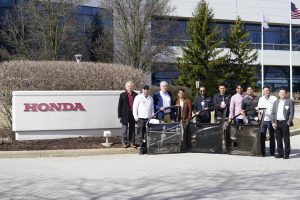Pre-consolidated thermoplastic blanks of polyamide 6 (PA6) reinforced with carbon fiber in a 2×2 twill weave fabric from Envalior were used to form a large door panel and a beltline stiffener. Once the parts were trimmed, these components were bonded to them with a methacrylate adhesive:
- A 3-part anti-intrusion beam featuring two mild steel brackets and one high-strength steel tube
- An aluminum outer beltline stiffener to stiffen the door’s outer panel
- An aluminum lower reinforcement to strengthen the base of the door
Developing forming techniques for a thermoplastic part the size of an auto door demanded creativity, says Sai Aditya Pradeep, a research and development engineer at Clemson who led the project’s manufacturing, assembly and testing. Finding large, pre-formed thermoplastic blanks for the door, which is approximately 1.6 x 1.4 meters, was difficult. Instead, the group fabricated their own by joining three 1 mm blanks together, staggering the joint across three layers to strengthen the seams and vacuum consolidating them into a single, 3 mm pre-consolidated blank.
Heating the blank presented another challenge. “We couldn’t really find a dual-sided infrared oven that was as big as these blanks. So, we retrofitted an old convection oven and had to find ingenious ways to transfer and hold the blank,” says Pradeep. Researchers developed a clamping system to hold the blank in a frame while it was heated, and the mostly molten matrix was removed from the oven and transferred to the press.
Once the final prototype was completed, the door was installed on a 2015 MDX and crash tested. The CFRTP door performed as expected and met or exceeded all safety parameters. The team has won several awards for its work, including a Process Innovation award in the Prototype Category from the Society of Plastics Engineers at the 2023 Automotive Composites Conference & Exhibition and a 2022 Team Award from the Department of Energy’s Vehicle Technologies Office.
Researchers are now working with Honda to design, develop and build a multi-material body-in-white for the OEM’s mid-size sports utility vehicle. The team includes members from Clemson University, University of Delaware and Ohio State University.
Pilla believes the outcomes of the door project, as well as the potential outcomes of the body-in-white project, have broader implications beyond the applications themselves.
“The success of these projects gives confidence to federal agencies that universities are not a place just to do basic research, but they are a place to do applied engineering work like this,” he says.
A team from Clemson University, University of Delaware, Honda and Envalior display the Acura MDX door featuring CFRTP components.
Photo Credit: Sai Aditya Pradeep, Clemson University
Scalable ‘Bridge in a Box’
Project: Modular GFRP Pedestrian Bridge
School: West Virginia University
Location: Morgantown, W.Va.
Principal Investigator: P.V. Vijay
Researchers from the West Virginia University Constructed Facilities Center (WVU-CFC) collaborated with Bedford Reinforced Plastics Inc. (BRP) on a modular GFRP pedestrian “bridge in a box” that can be scaled to span up to 70 feet, easily transported and quickly installed.
Pedestrian bridges are typically constructed with steel and timber, which are susceptible to corrosion and decay and require higher levels of maintenance. Recognizing the growing demand for pedestrian bridges, the WVU-CFC team extended decades of experience in designing, developing, testing and field monitoring GFRP solutions for the infrastructure and transportation sectors to pedestrian bridges.
The durability, light weight and strength of GFRP make it ideal for pedestrian bridges. “That’s where FRP plays a strong role. It has all those characteristics and much more,” says P.V. Vijay, principal researcher and associate professor in WVU’s Department of Civil and Environmental Engineering.
BRP contracted with the university to perform full-scale testing of a truss-style GFRP pedestrian bridge designed by Aldred D’Souza, PE, engineering director at the company. The bridge is made from pultruded parts that are pre-assembled into 5- to 10-foot-wide modules and shipped to the construction site, where they are bolted together to create a longitudinal span of 70 feet or longer.
All the components are made from GFRP, including beams, decking and the truss structure. The latter comprises hundreds of 2½ x 2½-inch or 3 x 8-inch box sections and 2½ x 10-inch or 2½ x 8-inch channel sections. The parts are joined together using steel bolts and nuts and tightened to a specified torque level. In addition, customers can select wood decking for aesthetic reasons or to reduce construction costs.
After the pedestrian bridge in a box concept was developed and manufactured by BRP, researchers tested a 10-foot-wide, 70-foot-long pedestrian bridge constructed in WVU’s materials and structures laboratories, where it underwent uniformly distributed load and vehicle load testing, dynamic excitation, equivalent wind load and other testing.
“We had nearly 100 strain gauges and linear variable differential transformers mounted on the bridge to measure member stresses and deformations,” Vijay recalls. “The whole bridge was instrumented and tested in close coordination with the WVU team.” Other university team members included Hota GangaRao, director, WVU-CFC; Joseph Ryan Virga, bridge engineer, WSP; Chao Zhang, engineering scientist, WVU-CFC; Mark Tennant, laboratory technician, WVU-CFC; and several graduate students.
The bridge in a box is now commercially available through Bedford Reinforced Plastics, which has installed more than 20 of the modular pedestrian bridges across the United States, ranging from bridges on remote hiking trails in public parks to ones on top-rated, private golf courses.
The initial cost of the GFRP bridge is higher than one constructed with conventional materials. However, the team believes that ease of transportation and installation, along with extended service life, offset those costs. In addition, the low maintenance of the bridges – which are expected to have a life span of 75 to 100 years – provide excellent long-term savings.
A truss-style pedestrian bridge constructed from GFRP pultruded parts that are pre-assembled into 5- to 10-foot-wide modules and bolted together.
Photo Credit: West Virginia University
Melissa O’Leary is a freelance writer in Cleveland. Email comments to melissa@good4you.org.




